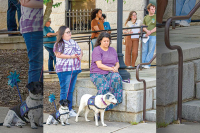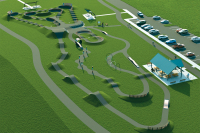One ski at a time: Anyone can learn how, says Cataloochee’s new ski school director
Mark Rozof sat behind a beat-up white desk surrounded by skis, walkie-talkies, snow jackets and other sundry gear strewn about the office, chuckling as he recalled his experiences as a ski instructor.
During his 23 years of teaching, Rozof, the new ski and snowboard school director at Cataloochee Ski Area, has collected a volume of tales, from those who fall flat on their face to kids who go on to be medal winners.
The most prominent memory, however, is about his youngest student — a three-year-old boy. The boy’s parents had planned to just let their son experience the snow and watch the other skiers, but they couldn’t keep him away.
“He saw the snow, and he got really excited about it,” Rozof said.
So the little boy’s parents bought him an hour-long lesson and stood by nervously watching him learn. Despite his age and lack of muscle development, the boy lasted the whole hour, Rozof said.
People nearby and on the ski lift clapped for the small child as he glided down a beginner, or bunny, slope on his tiny skis, surprised at his adeptness.
Related Items
“I bet I started a bad problem with him,” Rozof said. “He loved it.”
Rozof talks about skiing and teaching newbies like some people talk about addiction. A life on the slopes is something he can’t seem to get away from, not that he’d want to.
Growing up in southeast Michigan, skiing and snowboarding were a part of the culture. Rozof began skiing with his dad when he was 13.
“I saw the Olympics, and I liked it,” he said.
His first forray as a ski instructor was admittedly self-serving. Like other Michigan-area kids, Rozof just wanted a free season pass to the Pine Knob Ski and Snowboard Resort so he became an instructor.
“That’s where I learned to teach and pretty much learned to ski,” he said.
He went to college in West Virginia, where he continued to teach skiing, and then moved on to Seven Springs in Pennsylvania. He moved back to Michigan and started working in the automotive business, but like many became a causality of the declining industry — and so returned to his passion of skiing.
Utah, specifically Deer Valley, was Rozof’s most recent home, where he once again donned his skis to help the uncoordinated master the slopes.
About a year ago, Rozof started teaching at Cataloochee Ski Area, and he quickly moved up in the ranks to director of the ski school.
The job “kind of fell in my lap here,” he said.
Teaching at Cataloochee is “fun and a little more challenging,” Rozof said, because some first-time visitors don’t realize how chilly the slopes can get in North Carolina.
Vacationers from Southern states such as Alabama and Georgia are not used to the cold of higher elevations, and some do not dress appropriately for the weather, he said.
Cataloochee is the southern most ski slope in the East, and as a result, captures Southern skiers whose quest for snow leads them to Cataloochee as the closest resort.
“I’ve never heard so many y’alls on a ski slope in my life,” he said.
That close proximity to droves of Southerners seeking a taste of the slopes also means Cataloochee instructors get more than their fair share of novices.
When teaching, the instructors focus on getting their students acclimated to skis, which can feel cumbersome and gangling at first. After mastering the basics of moving and stopping, the new skiers take to the bunny slopes for straight runs, in which they simply ride down the hill with their skis facing forward.
Although the ski school tries to keep the instruction groups small, the holidays can be a busy time. Rozof suggests people pay the extra $30 to $180 for a private lesson, especially if they are already athletic, because the instructors can only move through the lesson as fast as the slowest learner. People who are apt to pick up skiing more quickly may get bored waiting for others to catch up.
Beyond private lessons, the ski school is hoping to remedy the problem by changing its teaching methods. Rather than each group having one instructor, beginners would move from station to station, where they would learn different skills at their own pace, Rozof said.
Rozof has a level three certification, the highest level, through the Professional Ski Instructors of America, meaning he can teach pretty much anywhere.
Eventually, Rozof, who has coached high school and middle school ski teams, said he also wants to bring NASTAR, or National Standard Racing, to Cataloochee. NASTAR is a grassroots ski race program, open to people of all skill levels. Participating ski resorts hold races throughout the winter, and the top racers from across the country are asked to compete in Nature Valley NASTAR National Championships.
Unlike many sports, such as football or basketball, skiing can be a solo activity.
“You can just do it yourself,” Rozof said. People of “any size, any weight, any height” can become great skiers, he said.
Currently, skiers and snowboarders can traverse Cataloochee’s lower trails, but the resort plans to open the upper trails as soon as possible, Rozof said.
The snow that covers the mountains of Cataloochee Ski resort is not visible from U.S. 19 in the valley below, which can be a hindrance when 50-degree weather keeps people’s minds from thoughts of a winter wonderland.
However, Cataloochee is open and ready for business — despite the day’s conditions, assured Rozof.
Let’s go ski!
Cataloochee Ski Area opened its slopes this past weekend and plans to remain open the rest of the season.
Where: 1080 Ski Lodge Road in Maggie Valley
When: 9 a.m. to 4:30 p.m. Monday through Friday, non-holiday. 8:30 a.m. to 4:30 p.m. Saturday, Sunday and Holidays. Open til 10 p.m. starting December 13.
Cost: The price of a lift ticket ranges from $18 to $71 depending on what day, how long you want to ski or snowboard, and day or night session. Adult equipment rentals run $23 for ski or $30 for snowboard. Group lessons are $20, and private lesson are between $25 and $200 depending on the length of the tutorial.









